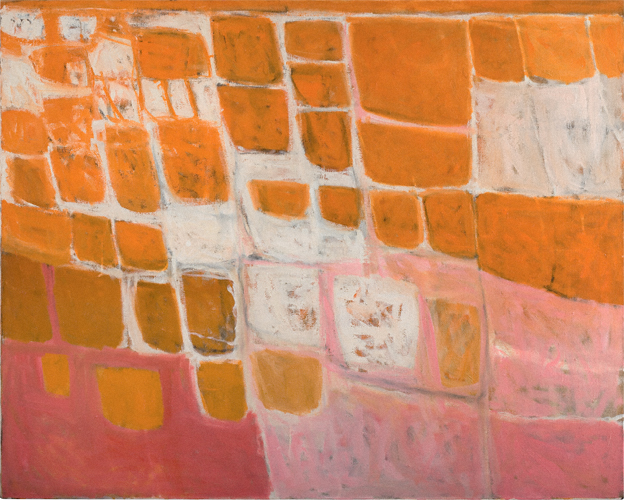
19 January 2016
The late David Bowie wasn’t just a phenomenal musician; he was also an art buff with an impressive collection of modern British art, says Colin Gleadell.
Most of the obituaries for rock star David Bowie refer to him not only as a musician, performer, style icon and artist, but also as an art collector. In 1998 he told the New York Times: “Art was the only thing I’d ever wanted to own”. In 1999 he told the BBC’s Jeremy Paxman that “the only thing I buy addictively is art”.
So what did he collect? He had a couple of Old Masters and some German Expressionist prints that jelled with his edgy Berlin period. But “the majority of what I have is British 20th century,” he told the New York Times. The best publicised in the post-mortem tributes were Peter Howson’s controversial 1994 Croatian Muslim war painting, and a 1995 Damien Hirst spin painting. Bowie also made loans to historical exhibitions for William Nicholson (1930s), Peter Lanyon (1950s), and Patrick Caulfield (1970s) – facts that are more the territory of the connoisseur. But while these examples indicate the range of his interests, they are only the tip of the iceberg.
The dealer closest to Bowie was Bernard Jacobson, a specialist in Modern British art at the time. In the mid-Eighties, Bowie began visiting his gallery interested in the deconstructed, figurative carvings of Glynn Williams. Soon he had developed an interest in many of the artists Jacobson dealt with. “He had a fabulous eye, and he was passionate,” remembers Jacobson. “He read a lot and learned fast. He bought examples by major British artists such as Ben Nicholson, Stanley Spencer, David Bomberg, Leon Kossoff and Frank Auerbach as well as some of the lesser known – Euan Uglow, Victor Willing and William Tillyer. He also bought a lot at auction.”
During the Nineties, Bowie and his art advisor Kate Chertavian became regular attendees at London’s Modern British art sales. There, I witnessed the purchase of scores of paintings and sculptures revealing a breathtaking scope of interest. In October 1993 they acquired a rare neo-romantic gouache by St Ives artist Bryan Wynter, for which he paid a record £11,270: five times the estimate.
The next month, they bought 11 more modern British works at auction; from a lovely early figurative William Scott, Girl at a Table, for which he paid a quadruple-estimate and record £45,500, to an expressionistic late Bomberg self-portrait within estimate for £18,400. The emphasis was on figurative art in all its modern guises. The month’s shopping list included two Ivon Hitchens watery landscapes; a Carel Weight (one of Jacobson’s older artists having a career revival after selling in bulk to Charles Saatchi); a stylish costume design by Christopher Wood and a double-headed bronze, Roman Actor, by Michael Ayrton.
The last two, bought for less than £2,000 each, were clearly stage-related, but the rest showed an impressive understanding of the variety of currents flowing through British art. They also bid, but unsuccessfully, on a “kitchen sink” painting by Jack Smith and an early abstract by Victor Pasmore.
But when he really wanted something, Bowie was prepared to bid high. In 1994, the year in which he joined the board and started to conduct interviews with artists for Modern Painters magazine, which was backed by Jacobson, he paid a record £111,500 for a classic Camden Town Group interior by Harold Gilman. That record stood for eight years.
Other works he snapped up were sculptures by Eduardo Paolozzi and by Barbara Hepworth’s assistant Denis Mitchell, paintings by Graham Sutherland (he preferred the early work) and the St Ives artists Terry Frost and Alexander MacKenzie.
He also began buying contemporary art outside of Jacobson’s orbit, paying a record £36,700 for an interior by Patrick Caulfield, and works by Julian Opie and Gilbert and George (all represented by other dealers), but his relationship with Jacobson didn’t cease. One day he went to the gallery and Jacobson had a 1994 painting by William Tillyer in his office in which the cool, minimal elegance of constructivist art confronts the romantic, exuberant luminosity of nature in a single canvas.
Although slightly overshadowed by the success of Howard Hodgkin, Tillyer is an artist Jacobson has worked with and believed in consistently since the late Seventies. “Bowie said he’d like to buy it, but I said I didn’t want to sell it,” recalls Jacobson. “I really loved it and wanted it in my office. But David persisted: ‘come on, you’re a dealer…you sell everything,’ he said.” Eventually Jacobson relented, but instead of selling it, gave it to him – a mark of friendship and respect.
What will happen to the Bowie collection now is anyone’s guess. Hopefully we’ll get to see it all together somewhere, sometime.
Please click here to read the original article:
www.telegraph.co.uk

